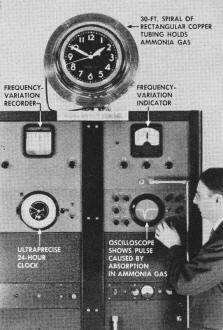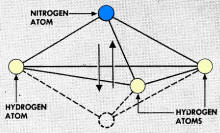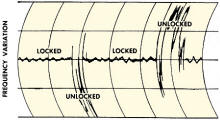Atoms Run New Superclock
|
|
This report on America's first operational atomic clock appeared in a 1949 issue of Popular Science magazine. The National Bureau of Standards (NBS), now called the National Institute of Standards and Technology (NIST), built an ammonia-based atomic clock which achieved the then unheard of uncertainty of plus or minus one second every 300 years. NIST's current atomic clock (NIST-F2) boasts an uncertainty of one second every 300 million years. It uses caesium-133 as a reference. Other factors enabling the greater accuracy is a more stable enclosure, high precision laser measurement, and cooling closer to absolute zero. Of course if the atom ever did reach absolute zero, it would stop vibrating and not be of much use - other than maybe as a direct current (DC) reference ;-) Atoms Run New SuperclockSteady vibrations of molecules of ammonia, in tubing wound around clock face, continuously correct oscillations of quartz crystal that controls speed of synchronous motor driving clock. Sketch of ammonia molecule shows how it ticks time. Nitrogen atom jumps up and down, turning pyramid-shaped molecule inside out, when fed energy at frequency of 23,870.4 mc. Frequency-deviation record of six-hour test run shows narrow variation in clock's speed when paced by ammonia molecule and wider deviations when running without that control. Ammonia - the stuff housewives use to clean windows - now keeps time. It is used in a new kind of clock, the first ever to make time-keeping independent of astronomical observations. Developed by the National Bureau of Standards, this clock is expected to help astronomers, navigators, and radio engineers. The rotation of the earth has been the time standard for centuries. But the earth doesn't always turn at the same speed. The new clock uses the ammonia molecule's vibrations as its standard. It compares those vibrations to the ticks of a quartz crystal, and adjusts the crystal so that it always ticks with the ammonia molecule, The crystal, in turn, controls an electric clock by changing DC to AC, whose exactly regulated cycles run the clock with extreme accuracy. All molecules and atoms vibrate, like ammonia, at some particular frequency. Each gets the energy for its vibrations by absorbing energy of a given frequency. In the case of the ammonia molecule, the vibration and absorption occur when energy is fed in at 23,870.4 megacycles. Microwaves generated by the quartz crystal enter one end of a 30-ft. tube filled with ammonia gas. As long as the microwaves are exactly at 23,870.4 megacycles, most of them are absorbed by the gas. When the crystal gets off the beat, however, more microwaves get through the ammonia to a detector at the other end of the tube. The detector then signals an electronic frequency discriminator, which brings the crystal back into tune with the ammonia. Yet even ammonia has its limitations. The present atomic clock is accurate to about one second in eight months. By using other atoms or molecules, still higher precision-as great as one second in 300 years - is expected. This exact control of wave frequencies may also permit squeezing more TV channels into the crowded radio spectrum, since each could fit into a narrower band.
Posted April 25, 2024 |
|



